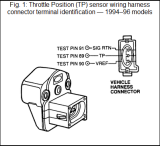TPS - Throttle Position Sensor
Throttle Position Sensor (TPS)
OPERATIONThe Throttle Position (TPS) sensor is a potentiometer which provides a signal to the PCM that is directly proportional to the throttle plate position. The TPS sensor is mounted on the side of the throttle body and is connected to the throttle plate shaft. The TPS sensor monitors throttle plate movement and position, and transmits an appropriate electrical signal to the PCM. These signals are used by the PCM to adjust the air/fuel mixture, spark timing and EGR operation according to engine load at idle, part throttle, or full throttle. The TPS is not adjustable. A faulty throttle position sensor or switch due to loose connections, bad grounds, high resistance in the circuit, or opens in the circuit can cause the described symptoms.
The Throttle Position (TP) sensor and accelerator pedal position (APP) sensor are the only sensors sending data to the Powertrain Control Module (PCM) that the vehicle operator has direct control over. The TP sensor is a three wire potentiometer that provides an analog signal to the computer. This signal represents how far the throttle plates have opened. The Powertrain Control Module calculates how much air should have entered the engine and compares this value with the Manifold Absolute Pressure (MAP) sensor or Mass Air Flow (MAF) sensor value. The PCM uses this information to calculate fuel delivery and ignition timing requirements. The PCM on vehicles equipped with an electronic transmission utilize the TP sensor in combination with the MAP and MAF sensor values to determine shift schedules and torque converter clutch application.
Throttle Position Sensor Symptoms
- Bucking
- Hesitation
- Stumble
- Chuggle
- Stalling on Acceleration
Throttle Position Sensor Testing
- Disconnect the negative battery cable.
- Disengage the wiring harness connector from the TP sensor.
- Using a Digital Volt-Ohmmeter (DVOM) set on ohmmeter function, probe the terminals which correspond to the brown/white and gray/white connector wires on the TP sensor. Do not measure the wiring harness connector terminals, but rather the terminals on the sensor itself.
- Slowly rotate the throttle shaft and monitor the ohmmeter for a continuous, steady change in resistance. Any sudden jumps or irregularities in resistance (such as jumping back and forth) indicates a malfunctioning sensor.
- Reconnect the negative battery cable.
- Turn the DVOM to the voltmeter setting.
- WARNING
Ensuring that the DVOM is set to the voltmeter function is vitally important, because if you measure circuit resistance (ohmmeter function) with the battery cable connected, your DVOM will be destroyed. - Detach the wiring harness connector from the PCM (located behind the lower right-hand kick panel in the passenger compartment), then install a break-out box between the wiring harness connector and the PCM connector.
- Turn the ignition switch ON and using the DVOM set to its voltmeter function, measure the voltage between terminals 89 and 90 of the breakout box. The specification is 0.9 volts.
- If the voltage is outside the standard value or if it does not change smoothly, inspect the circuit wiring and/or replace the TP sensor.
Throttle Position Sensor Adjustment
NOTE: The TP sensor is not adjustable on most models. Adjustable TP sensors have elongated mounting holes to allow adjustment.
1.If necessary, remove the EGR valve and heat shield from engine.
2.Using three 6 in. (152mm) jumpers, connect the TP sensor harness to the TP sensor.
3.With ignition ON, engine stopped, use a digital voltmeter to measure voltage between the bottom and middle terminals.
4.Loosen the two TP sensor attaching screws and rotate the sensor to obtain a voltage reading of 0.450–1.250 volts.
5.With the ignition OFF, remove the jumpers and reconnect TP sensor harness to TP sensor.
6.Install the EGR valve and heat shield to engine, using new gasket as necessary.
7.Install the air cleaner gasket and air cleaner to throttle body unit.
Throttle Position Sensor Replacement
REMOVAL & INSTALLATION- Disconnect the negative battery cable.
- Disengage the wiring harness connector from the TP sensor.
- Remove the two TPS sensor mounting screws, then pull the TP sensor out of the throttle body housing.
-
To install:
- Position the TPS sensor against the throttle body housing, ensuring that the mounting screw holes are aligned. When positioning the TP sensor against the throttle body, slide the sensor straight onto the housing.
- Install and tighten the sensor mounting screws until snug.
- Attach the wiring harness connector to the sensor, then connect the negative battery cable.
NOTE: The TPS sensor is not adjustable on newer vehicles(1996 and up)

Car Engine Sensors :
- Powertrain Control Module (PCM)
- Throttle Position (TP) sensor
- Mass Air Flow (MAF) sensor
- Intake Air Temperature (IAT) sensor
- Idle Air Control (IAC) valve
- Engine Coolant Temperature (ECT)
- Heated Oxygen Sensor (HO2S)
- Camshaft Position (CMP) sensor
- Knock Sensor (KS)
- Vehicle Speed Sensor (VSS)
- Crankshaft Position (CKP) sensor
- Engine Trouble Codes




